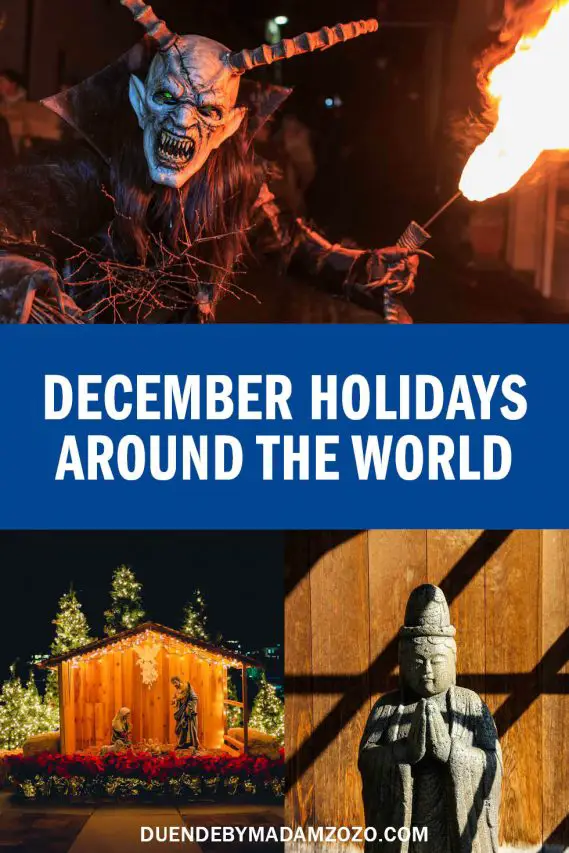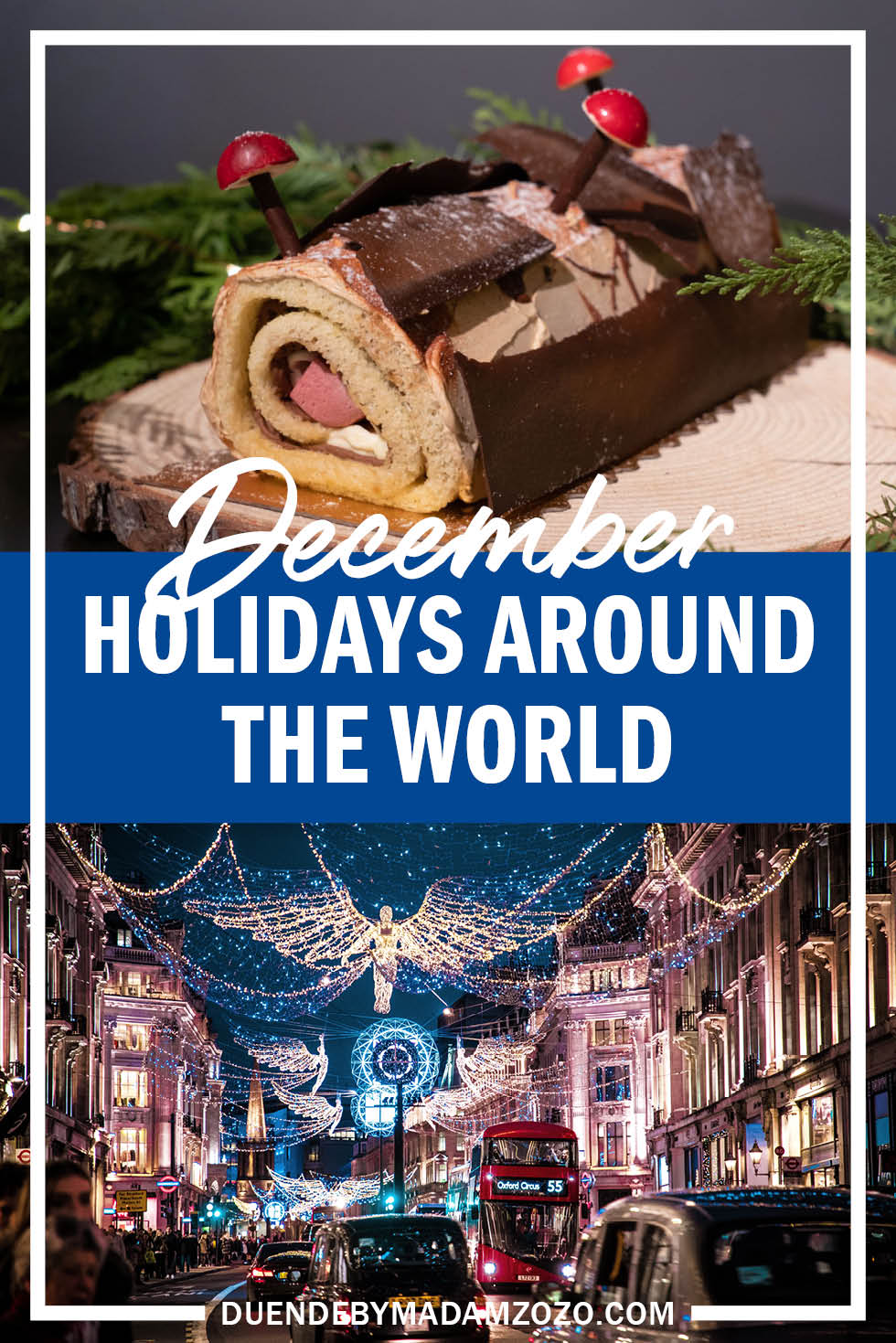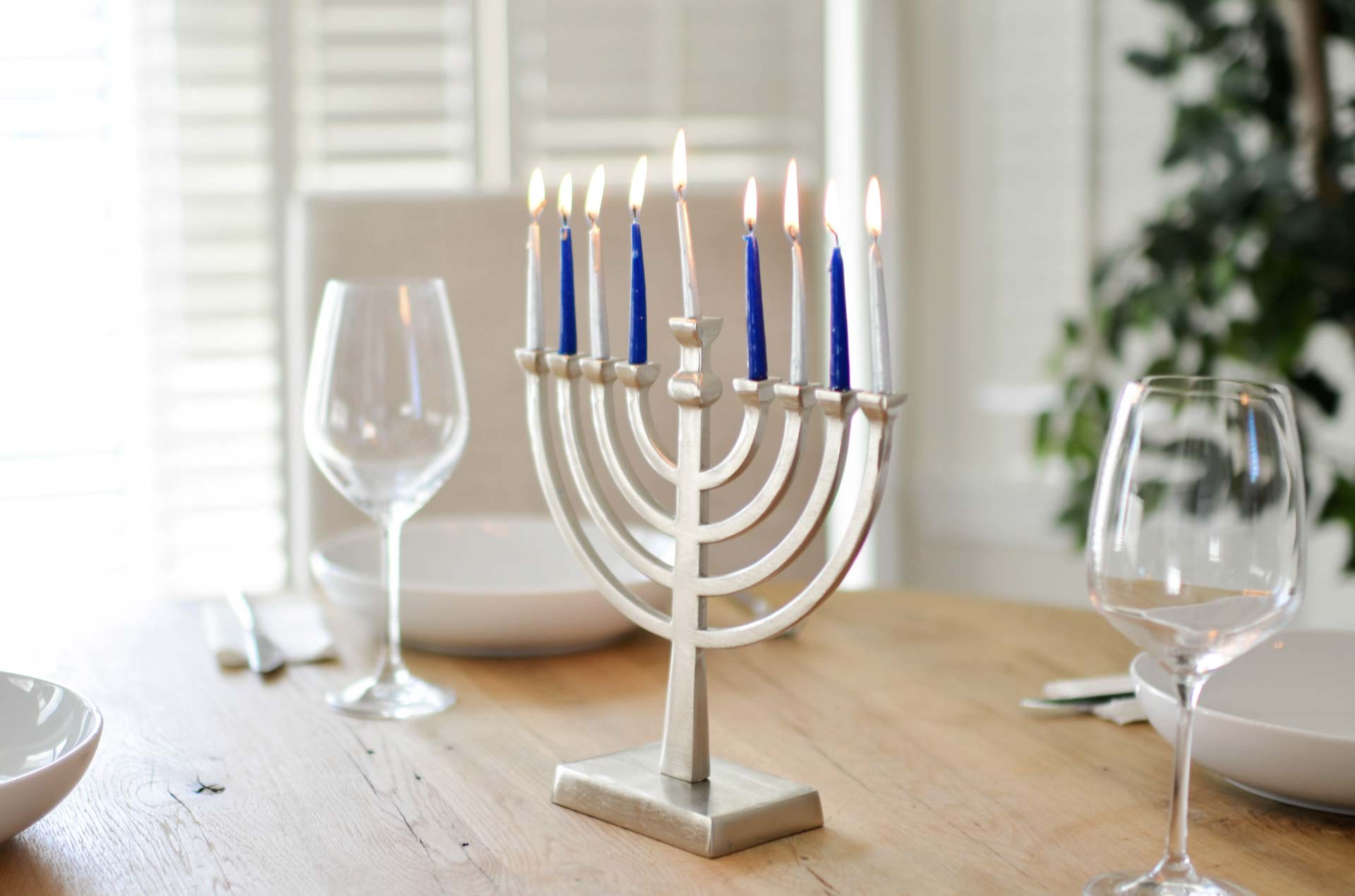December is a month packed full of holidays around the world. Winter solstice festivities are in full swing throughout the Northern Hemisphere as well as Jewish, Buddhist, Hindu and Christian religious holidays. Here is a 101 on the origin and traditions of some prominent celebrations or remembrances, as well as where to join in the fun and the appropriate greeting for sending well wishes to those observing the occasion.
December holidays around the world
2-10 December – Hanukkah
8 December – Bodhi Day
5 December – Krampusnacht
5/6 December – Feast of St. Nicholas
21-25 December – Pancha Ganapati
21 December – 1 January – Yule
21 December – Dōngzhì Festival
25 December – Christmas Day
26 December – 1 January – Kwanzaa
Hanukkah – lit up in dedication
Hanukkah or Chanukah, meaning “dedication”, is an eight-day festival of lights celebrated by those of the Jewish faith. The occasion celebrates the rededication of the Holy Temple in Jerusalem in the second century BC, after it was won back from the Seleucids (ancient Hellenistic Greeks). As part of the Temple’s rededication, the Menorah (a seven-lamp candelabrum) was lit using the only pot of olive oil left uncontaminated by the Greeks. The one-day supply of oil is said to have miraculously fueled the menorah for eight days. Hanukkah memorializes this miracle on the 25th day of Kislev, a month on the lunar-based Jewish calendar, therefore the dates are variable from year to year.
Hanukkah traditions including the nightly lighting of a nine-lamp menorah. The ninth candle being the shamash (attendant) which is used to light the others. Each night a lamp is kindled until there are eight flames. Blessings are recited before lighting the menorah and traditional songs follow. Menorahs in each household are placed in a doorway or window. In reference to the oil, fried foods are eaten such as latke (potato pancakes) and sufganya (jelly-filled doughnuts). Four-faced spinning tops known as dreidel bearing the acronym for “a great miracle happened there” is used in a game played for coins, nuts or other prizes. Adults may gift gilt (small sums of money) to children.
Experiences: Hanukkah is not biblically ordained and is a relatively minor festival for Jewish people. Celebrations usually take place in private homes. That being said, there are several cities around the world where giant menorahs are lit in public places, accompanied by music and food. Jerusalem is an obvious choice for observing traditions, however you may also catch festivities in London’s Trafalgar Square, New York City’s Grand Army Plaza, Miami’s Euclid Circle, the Belgian city of Antwerp and Rome, Italy.
Greetings: “Hanukkah Sameach!” meaning happy Hanukkah in Hebrew, or “Chag Sameach!” translating to happy holiday.
Bodhi Day (Rohatsu in Japan) – enlightenment
Mahāyāna Buddhists, generally from east Asian countries China, Japan, Korea and Vietnam, commemorate the enlightenment of the first Buddha on Bodhi Day. Siddhartha Gautama was a Nepali Prince who left his life of privilege to seek answers to life’s suffering. Gautama sat down under a bodhi tree (scientific name: Ficus religiosa, common name: Sacred fig) in northeast India and entered several days of intense meditation. He concluded his meditation only when he had reached “enlightenment.” His knew knowledge became the principles of Buddhism and he was then known as Buddha (aka Shakyamuni).
Bodhi Day was originally observed on the 8th day of the 12th lunar month, which varies each year. Once Japan adopted the Gregorian calendar, Buddhist holidays were given fixed dates and Bodhi Day was assigned December 8th. The Day is usually observed quietly in meditation. Some bring a sacred fig into their home and decorate it with coloured lights that represent the many pathways to enlightenment, and ornaments that symbolise The Three Jewels of Buddhism: The Buddha, Dharma (Buddha’s teachings) and the Sangha (Buddhist community).
Experience: There are no great parades or public celebrations of Bodhi Day. You may see quiet observances by Buddhists in China, Japan, Korea or Vietnam. Keep your eyes peeled around viharas (Buddhist monasteries) and stupas.
Greetings: Bodhi Day has no traditional greeting, but “Budu saranai,” meaning may the peace of the Buddha be yours, wouldn’t be inappropriate.
Krampusnacht – Demon’s night out
Krampusnacht falls on the night of December 5, the eve of the Feast of St Nicholas in central Europe. Krampus is a loathsome stick-wielding half-goat, half-demon originating in pre-Germanic pagan tradition. Krampus has various incarnations and is often used to represent the Christian devil.
On Krampusnacht (Krampus Night), Krampus terrorizes misbehaved children as a counterpart to St Nicholas (the early Christian Bishop who is the model for modern Santa Claus). Men dressed as the two opposing characters, visit homes and businesses to dole out gifts or punishment as they see fit.
Krampusnacht festivities across areas of Alpine Europe usually involve Krampuslauf (Krampus run) where young men dressed as the demon, parade through village streets whipping bystanders with their sticks. Their wooden Krampus masks are carved by skilled artisans and costumes are made of sheep or goat skins.
Experience: Krampusnacht celebrations are concentrated in Southern Germany, Austria and the South Tyrol region of northern Italy. Krampus balls or costume parties are increasingly popular and have spread to North America. Look for events in cities such as Toronto, New York, Los Angeles, Chicago and Washington DC.
Greetings: None.



Feast of St Nicholas (or St Nicholas Day) – the original Santa
St Nicholas Day is celebrated on December 6 (in some places December 5) in honour of a 4th-century bishop that resided in Myra, Ancient Greece (now Demre, Turkey). St Nicholas was orphaned at a young age and his parents left him a healthy inheritance. Over his lifetime, Nicholas gained a reputation for leaving anonymous gifts for people in need. He was known for his unique delivery method—dropping small presents and coins into people’s shoes. St Nicholas Day is not to be confused with Christmas, though the bishop’s gift-giving was the inspiration for modern Santa Claus.
St Nicholas Day is celebrated throughout Europe in numerous ways, generally involving gifting to children and a family meal. In contrast, Balkan nations Greece, Albania, Serbia and Bulgaria, fast instead of handing out presents. In Greece, St Nicholas is considered a protector of sailors and boats are decorated for the occasion.
Experience: St Nicholas Day is generally not a public holiday and celebrations are small, private affairs. Parades are common in cities of the Netherlands. In North America, look for celebrations in towns that have strong German immigrant history such as Pittsburg, Pennsylvania; Cincinnati, Ohio; Fredericksburg, Texas; and Milwaukee, Wisconsin.
Greetings: No known traditional greeting.
Pancha Ganapati – Hindu holiday
Pancha Ganapati is a modern Hindu holiday seeded in 1985 by Californian born Satguru Sivaya Subramuniyaswami who adopted Shaivism (a branch of Hinduism) in his youth. For many Hindus living in Western parts of the world, this holiday was created to share in the holiday season without compromising Hindu beliefs. It is based on Lord Ganesha, the elephant-headed god of culture and the arts who is usually worshipped by Hindus around the time of winter solstice. Pancha Ganapati is a five-day celebration from December 21 to 25. Each day, families focus on one of five aspects of their life: family; friends and close community; business associates and public; culture; and religion.
Pancha Ganapati is the five-headed form of Ganesaha and a household shrine is created in the god’s honour depicting him emerging from a forest. Each morning children redress the shrine in the colour of the day in order: yellow, blue, red, green and orange. Pancha Ganapati is celebrated with family meals, outings such as picnics and traditional songs of praise. Each day a gift is presented to children who place them at the shrine for Pancha Ganapati to bless. Only on the fifth day are they opened.
Experience: No known public celebrations.
Greetings: In English, “Merry Pancha Ganapati!”
Yule, Alban Arthuan, and Saturnalia – pagan party
Ancient cultures of the northern hemisphere celebrated the winter solstice with varying traditions. The Norse revered the returning of the sun after the shortest day/longest night of the year taking Yule (or Jul) into January. The Celts also partied through the darkest days of winter in a festival named Alban Arthuan. Germanic people honoured their pagan god Oden, with Yule also. Meanwhile, Ancient Romans worshipped Saturn, god of agriculture at this time with appropriately named Saturnalia.
Nordic, Roman and Celtic traditions include varied combinations of bonfires, wassailing crops (toasting to plentiful harvests), eating freshly slaughtered meat, sacrifices, decorating a Yule tree and burning of a specially chosen yule log. During Alban Arthuan, Celts carolled and decorated their homes in holly and ivy, which were thought to protect against evil spirits. Mistletoe was also used for its supposed magical properties.
Experience: Yule has all but been swallowed up by Christmas, except in circles of modern Pagans, many of which descend on England’s Stonehenge for the occasion. See the following recommendations for witnessing/participating in Christmas celebrations.
Greetings: “Happy Yuletide” or “Joyous Yule” in English, “God jul” meaning good Yule in Danish, Norwegian, and Swedish.
Dōngzhì Festival – Solstice celebration
Another Northern Hemisphere solstice celebration is Dōngzhì, translating to “the extreme of winter.” Dōngzhì Festival takes place in China and parts of east Asia such as Taiwan, Japan, Vietnam and Korea. The celebration falls around the 21-22 December each year. It originated in the Han Dynasty (202 BC – 220 AD), from the principle of yin and yang – balance and harmony. In Chinese astrology, yin represents female energy and darkness (among other things), while yang is masculine and light. Dōngzhì celebrates the longest night of the year, in anticipation of the yang returning with longer days.
Dōngzhì is not an official holiday in China, although historically people did take the day off. The two most important traditions of the festival are gathering with family to eat a warm meal and ancestor worship. In southern China typical Dōngzhì food includes tangyuan. These balls made with glutinous rice flour are filled with sweet sesame or red bean paste, and usually served in a ginger broth.
In the north, where winters are much harsher, dumplings are popular. According to folklore, Han dynasty physician Zhang Zhongjing noticed the frostbitten ears of poor farmers. He had his apprentices serve them up mutton dumplings to warm them. People continue the tradition of eating dumplings today as well as other nourishing, warming foods. In Taiwan, ancestors are offered nine-layer cakes, and in Korea red bean porridge is eaten.
Experience: No known public celebrations.
Greeting: In English, “Happy Dōngzhi” or “Happy Festival”.
Christmas Day – Jesus’ birthday
Christmas Day is a celebration of the birth of Jesus Christ, thought to be an incarnation of the Christian god. During the 4th century, Pope Julius I assigned the 25th December for the celebration of Jesus’ unknown birthday in Bethlehem. It is theorized that by aligning Jesus’ birthday celebration with existing holidays, would help to convert Pagan populations to the relatively new religion.
The oldest symbolism and traditions of Christmas are heavily tied to the nativity story that depicts the events leading up to and immediately after Jesus’ birth. Others were adopted from preceding pagan celebrations or evolved in more recent times. Carolling and hanging mistletoe come from old Celtic traditions. Decorating a tree and burning a yule log are adopted from Nordic and Germanic Yule. Children in some countries such as the USA, UK and Australia expect a visit from Santa Claus or Father Christmas, a fictional gift-giving adaption of the aforementioned St Nicholas. On Christmas Eve or Christmas Day, families usually share a feast and exchange gifts. Though Christmas has become a widespread secular event, Christian observers usually attend special church services.
Experience: Bethlehem is an obvious choice as the geographic centrepiece of the Christmas story. For traditional Christmas experiences including specialty markets try Prague, Czech Republic; Nuremberg, Germany; Strasbourg, France or Salzburg, Austria. You can even visit Santa Claus’ “house” in Lapland, Finland. Less traditional options range from San Miguel de Allende, Mexico; to New York City, USA.
Greetings: “Merry Christmas,” “Happy Christmas,” or “season’s greetings.”
Kwanzaa – African heritage
Kwanzaa or Kwanza is a seven-day celebration of African culture and heritage by African Americans and African diasporas around the world. Kwanzaa is celebrated from December 26-January 1. The holiday was created in 1966, at a time of deep socio-political unrest in the US. California State University professor, Maulana Karenga lead the idea. It was intended to celebrate heritage, promote unity and preserve African culture. The name Kwanzaa comes from the Swahili phrase meaning first fruits. Swahili was chosen because it is not linked to a particular geographic area or people.
Kwanzaa traditions were derived from several African harvest festivals. There are seven principles (or Nguzo Saba): unity, self-determination, collective responsibility, cooperative economics, purpose, creativity and faith. Each principle is represented on a seven-branch candelabra called a kinara which is lit one per day of the festival. On December 31, a feast is shared by participants with several ceremonial components. Gifts are exchanged though this is not a focus and presents are generally homemade and/or share elements of African heritage.
Experiences: Celebrations tend to be private or within small community groups.
Greeting: “Habari gani” is the Swahili greeting which translates to what’s the news? The expected response is the principle of the day also in Swahili.
Whether you are at home or travelling abroad, seek out one of these wonderful celebrations and crank up your cultural awareness, with some seasonal fun.
Peace, love & inspiring travel,
Madam ZoZo




